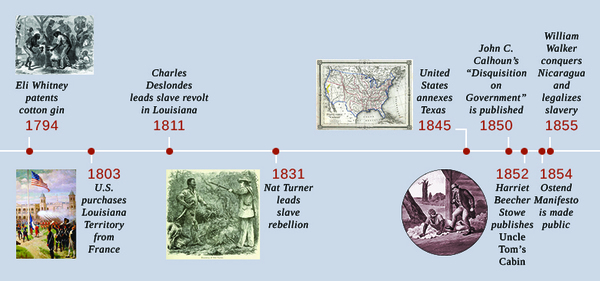| << Chapter < Page | Chapter >> Page > |

In the antebellum era—that is, in the years before the Civil War—American planters in the South continued to grow Chesapeake tobacco and Carolina rice as they had in the colonial era. Cotton, however, emerged as the antebellum South’s major commercial crop, eclipsing tobacco, rice, and sugar in economic importance. By 1860, the region was producing two-thirds of the world’s cotton. In 1793, Eli Whitney revolutionized the production of cotton when he invented the cotton gin , a device that separated the seeds from raw cotton. Suddenly, a process that was extraordinarily labor-intensive when done by hand could be completed quickly and easily. American plantation owners, who were searching for a successful staple crop to compete on the world market, found it in cotton.
As a commodity, cotton had the advantage of being easily stored and transported. A demand for it already existed in the industrial textile mills in Great Britain, and in time, a steady stream of slave-grown American cotton would also supply northern textile mills. Southern cotton, picked and processed by American slaves, helped fuel the nineteenth-century Industrial Revolution in both the United States and Great Britain.
Almost no cotton was grown in the United States in 1787, the year the federal constitution was written. However, following the War of 1812, a huge increase in production resulted in the so-called cotton boom , and by midcentury, cotton became the key cash crop (a crop grown to sell rather than for the farmer’s sole use) of the southern economy and the most important American commodity. By 1850, of the 3.2 million slaves in the country’s fifteen slave states, 1.8 million were producing cotton; by 1860, slave labor was producing over two billion pounds of cotton per year. Indeed, American cotton soon made up two-thirds of the global supply, and production continued to soar. By the time of the Civil War, South Carolina politician James Hammond confidently proclaimed that the North could never threaten the South because “cotton is king.”
The crop grown in the South was a hybrid: Gossypium barbadense , known as Petit Gulf cotton, a mix of Mexican, Georgia, and Siamese strains. Petit Gulf cotton grew extremely well in different soils and climates. It dominated cotton production in the Mississippi River Valley—home of the new slave states of Louisiana, Mississippi, Arkansas, Tennessee, Kentucky, and Missouri—as well as in other states like Texas. Whenever new slave states entered the Union, white slaveholders sent armies of slaves to clear the land in order to grow and pick the lucrative crop. The phrase “to be sold down the river,” used by Harriet Beecher Stowe in her 1852 novel Uncle Tom’s Cabin , refers to this forced migration from the upper southern states to the Deep South, lower on the Mississippi, to grow cotton.

Notification Switch
Would you like to follow the 'U.s. history' conversation and receive update notifications?